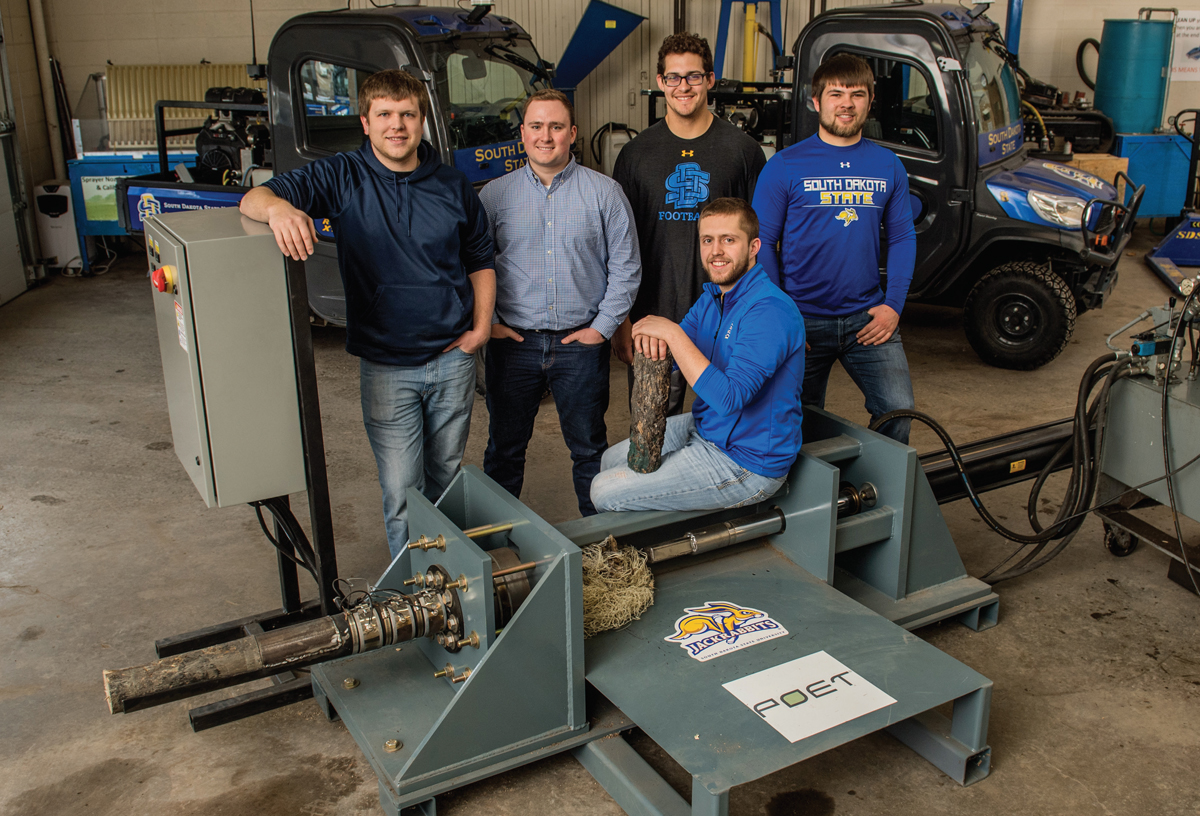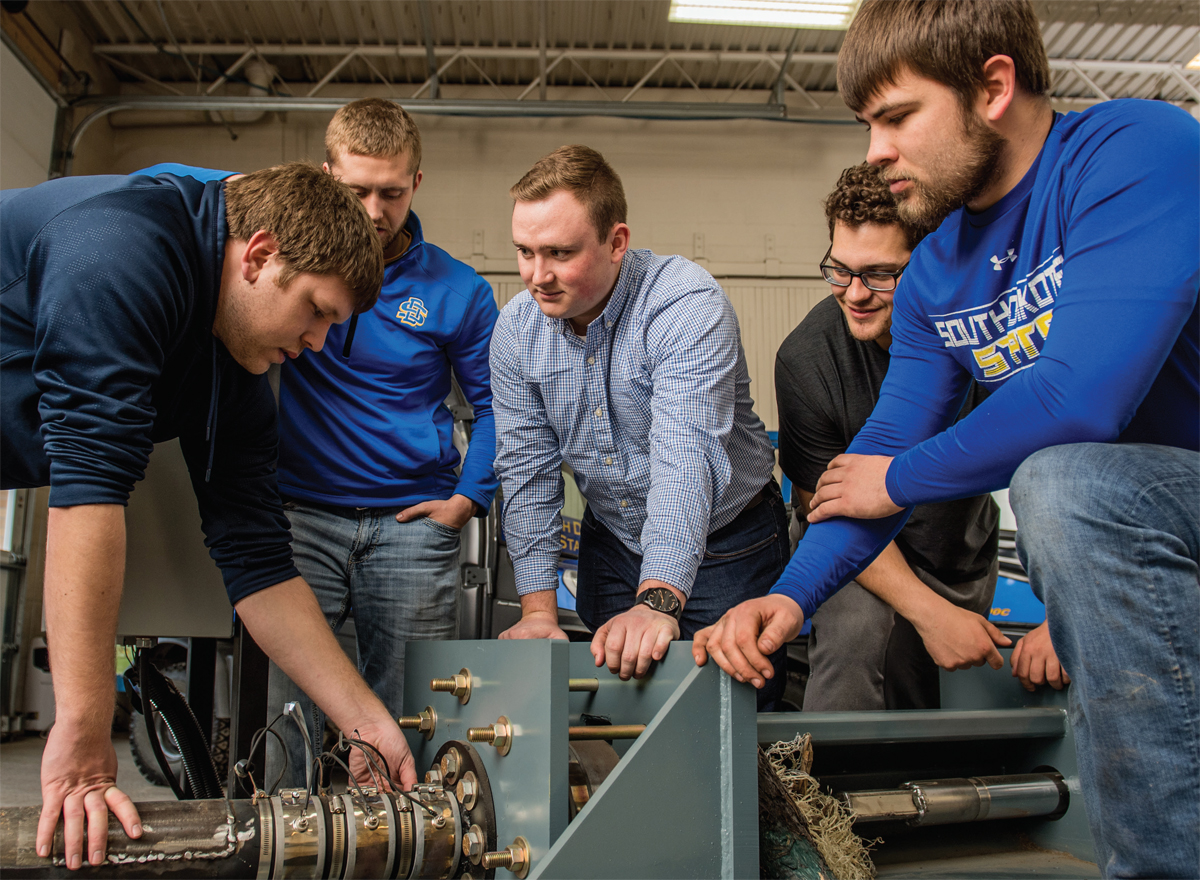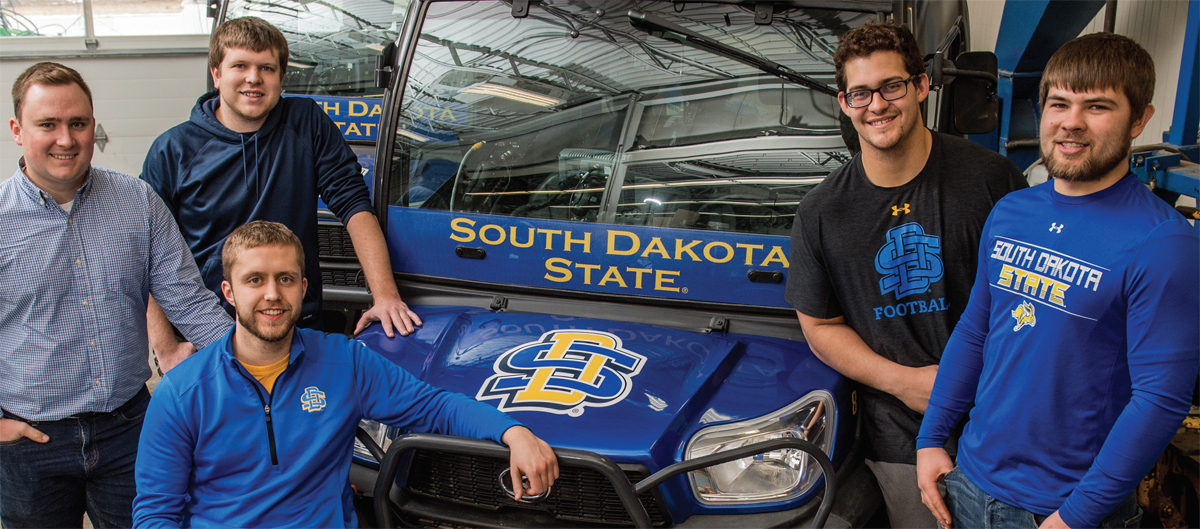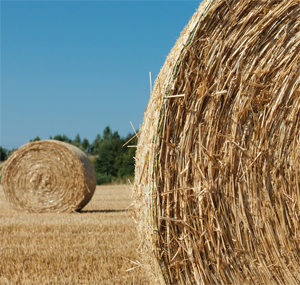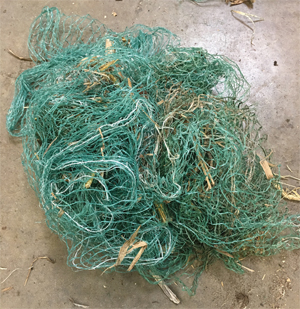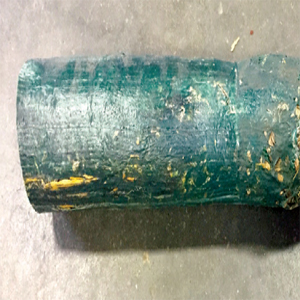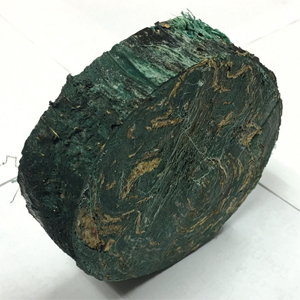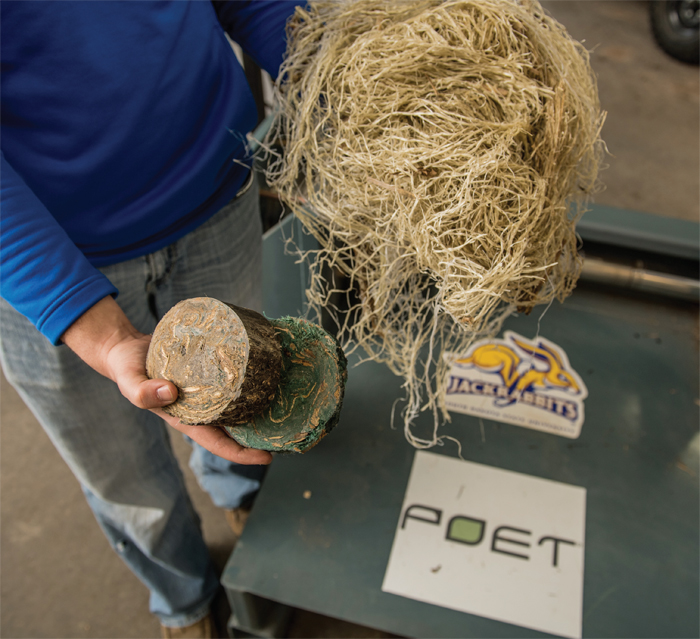Mitchell Sandey, Colin LeBrun, Caleb Lang, Brady Buck and Alex Koepke with the prototype in South Dakota State University’s Ag Engineering lab.
Part 1 of a series that focuses on POET’s partnerships with area universities.
In many college engineering courses, project scenarios come from a textbook and lack real-world constraints, like having to account for criteria such as speed, safety and cost.
In other words, students might size a cylinder but not have to consider cost. That’s not the case at South Dakota State University (SDSU) in Brookings, S.D.
SDSU’s Senior Design Capstone Program in the Department of Agricultural and Biosystems Engineering (ABE) allows students to tackle an industry-based project — and all the real-world loopholes, nuances and challenges that come with it.
Students have the opportunity to select a project offered by a variety of companies. Industry sponsors present an engineering challenge for the two-semester course, designate a company point person, and supply funding to build prototypes and mockups.
Colin LeBrun, a 2017 SDSU graduate who is now an engineer for POET, had his first opportunity to design a prototype from scratch during the capstone course. LeBrun, who had worked twice as an intern for POET, contacted the company in 2016 to ask if they had any potential projects for the course.
POET presented a project to solve a material handling challenge at Project LIBERTY — POET-DSM Advanced Biofuels’ commercial scale cellulosic biofuels facility in Emmetsburg, Iowa — with the goal of eventually using it on site.
LeBrun and two other classmates designed a prototype to more efficiently handle and compact the large volumes of netwrap and twine removed from corn stover bales entering Project LIBERTY. POET has developed a machine to remove the netwrap and twine from the bales, but the material proves cumbersome to transfer to the solid fuel boiler in order to reuse it for energy for the plant.
“If we can get that back into the solid fuel boiler easily, it has great BTU value [British thermal unit, a traditional unit of heat]. We can burn the plastic and create steam for the plant,” says Todd Peterson, Milling and Material Handling Manager, POET Design & Construction, who has been a POET advisor on the project since fall 2016. “We thought, if we can densify it, that would be an advantage to us in terms of how we handle the raw volume of the material. What we’re exploring is the densification of the material.”
SDSU Ag Engineering students discuss the project with POET engineer and SDSU alumnus Colin LeBrun (center), who serves as an advisor for the project.
In phase one of the project last academic year, LeBrun and SDSU students Cody Myers and Grant Bose developed a workable prototype. Students worked on a multistep approach in designing the prototype that involved machine design, hydraulic calculation and electrical schematics.
The prototype, using a hydraulic ram, compresses the material and then melts it into a tube shape. The project won first place in the industrial category for SDSU’s College of Engineering Design Expo.
“They did a great job, and they seemed to really enjoy it. It’s a real-world application on a piece of equipment that nobody has ever developed for this specific application. You can see the real-world value of this not only for cellulosic biofuel but also for anyone who handles this volume of bales,” Peterson says.
LeBrun now serves as the point person for the 2017-2018 capstone course students who are working on phase two of the project. Jud Evanson, Milling & Materials Handling Engineer, POET Design & Construction, also serves as a POET advisor along with Peterson.
Phase two of the project involves working on the feeding device in the front of the machine and the cutting device on the back end. A lagging issue from the prototype from phase one was that the machine needed to be manually fed the material. “You had to physically take the netwrap off and feed it into the chamber. One of our main tasks was to get the netwrap into that extrusion chamber,” says SDSU senior Caleb Lang, who is working on phase two of the project along with Mitchell Sandey, Alexander Koepke and Brady Buck.
The students arrived at the idea to use two cylinders. They ran a few ideas past LeBrun and Peterson and then made more design changes.
The second part of their work this year has been to automate the sizing system. They noticed that the sizing of the end material was inconsistent. Their model uses a hydraulic cylinder to push forward a hydraulically actuated saw blade to size the log-shaped material into 4-inch-thick pucks.
For Buck, the industry collaboration and real-time feedback is motivating. “It’s exciting to know we can test our ideas. You definitely take more pride in your work. You’ll either benefit or suffer from the work you put in beforehand.”
That’s a lesson that lasts beyond a final exam grade. “At the end, our students get to see their projects in action and listen to the feedback from the people that will be using our product. Students will remember the industry feedback much longer than they ever will remember a grade on a homework assignment,” says Van Kelley, PhD, Department Head of ABE at SDSU.
The goal is to develop a workable prototype by this spring and do further testing at Project LIBERTY. “Hopefully it’s a robust-enough design to stand up to the commercial environment. The next step is to automate it, which is something we would do in house with the process automation team,” Peterson says.
This industry collaboration offers benefits on all sides. “It’s a great opportunity for POET to engage students on something that is an active problem looking for a solution for POET. It’s a great thing to get a dedicated group of students on it and let them work toward a solution,” Peterson says.
Kelley agrees. “Our faculty come to campus every day with the goal to inspire the nation’s next generation of innovators and leaders in agriculture. Strong industry connections with innovators like POET keep our students at the forefront of the agricultural industry.”
The Senior Design Capstone Program offers myriad benefits to students. They have the opportunity to learn collaboration skills and ways to improve their projects, notes Douglas Prairie, P.E., Instructor of Agriculture and Biosystems Engineering at SDSU. “Students learn project communication skills and learn to see themselves as independent contractors on a project. They learn budget estimation, time management and collaboration skills, as well as how to improve their projects,” Prairie noted.
Peterson says part of the value for POET is to help with talent development at POET. “It keeps us in contact with these up-and-coming engineers. We want to know them. We want to talk with them. If we can engage them early on in internships and engage them in programs like this and they like it, that keeps the pipeline going for POET,” Peterson says.
Colin LeBrun, Brady Buck, Mitchell Sandey, Caleb Lang and Alex Koepke work on the project in South Dakota State University’s Ag Engineering lab.
ABOUT THE POET-SPONSORED SDSU STUDENT DESIGN PROJECT
Project LIBERTY utilizes corn stover as a feedstock to produce cellulosic biofuel. The stover is delivered to the plant in bale form. The round bales are wrapped by three layers of a polyethylene netting, while the squares are held together with six strands of polypropylene twine.
The first step in the conversion of stover to biofuel at Project LIBERTY is to remove the netwrap and twine from the bales. POET uses a specially developed net wrap remover to separate the netting and twine from the bales. Once removed, the plastic is used as an energy source by burning it in the plant’s solid fuel boiler to create steam for the rest of the plant processes. The netting and twine are bulky, so an efficient method of conveying these materials to the boiler is highly desirable.
The prototype designed by the SDSU students condenses the netwrap and twine that is removed from corn stover bales entering Project LIBERTY. The netwrap and twine is condensed into a log shape at the end of the process. Phase two of the process involves automating the sizing system at the back end of the process to size the log-shaped material into 4-inch pucks to more easily transfer it to the solid fuel boiler.
The net wrap and twine is condensed into a log shape by the end of the process.
